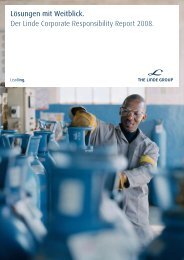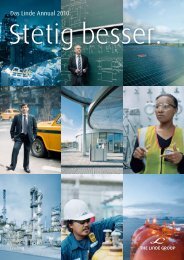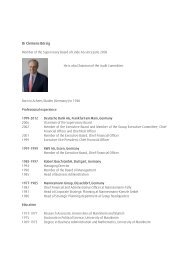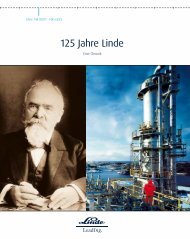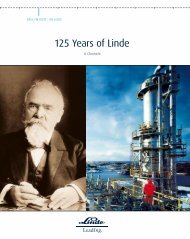Download Introductory Slides - The Linde Group
Download Introductory Slides - The Linde Group
Download Introductory Slides - The Linde Group
Create successful ePaper yourself
Turn your PDF publications into a flip-book with our unique Google optimized e-Paper software.
<strong>Linde</strong> Capital Market Day 2012<br />
Breakout Energy/Environment<br />
Prof. Dr A. Belloni<br />
Dr A. Opfermann<br />
12 September 2012, Munich
Disclaimer<br />
This presentation contains forward-looking statements about <strong>Linde</strong> AG (“<strong>Linde</strong>”) and their respective<br />
subsidiaries and businesses. <strong>The</strong>se include, without limitation, those concerning the strategy of an integrated<br />
group, future growth potential of markets and products, profitability in specific areas, the future product<br />
portfolio, development of and competition in economies and markets of the group.<br />
<strong>The</strong>se forward looking statements involve known and unknown risks, uncertainties and other factors, many of<br />
which are outside of <strong>Linde</strong>’s control, are difficult to predict and may cause actual results to differ significantly<br />
from any future results expressed or implied in the forward-looking statements on this presentation.<br />
While <strong>Linde</strong> believes that the assumptions made and the expectations reflected on this presentation are<br />
reasonable, no assurance can be given that such assumptions or expectations will prove to have been correct<br />
and no guarantee of whatsoever nature is assumed in this respect. <strong>The</strong> uncertainties include, inter alia, the risk<br />
of a change in general economic conditions and government and regulatory actions. <strong>The</strong>se known, unknown and<br />
uncertain factors are not exhaustive, and other factors, whether known, unknown or unpredictable, could cause<br />
the group’s actual results or ratings to differ materially from those assumed hereinafter. <strong>Linde</strong> undertakes no<br />
obligation to update or revise the forward-looking statements on this presentation whether as a result of new<br />
information, future events or otherwise.<br />
2
Mega-trend Energy/Environment<br />
<strong>The</strong> world is changing<br />
1 Fossil fuels increasing<br />
2<br />
80%<br />
Mtoe<br />
18<br />
16<br />
14<br />
12<br />
10<br />
8<br />
6<br />
4<br />
2<br />
0<br />
2009<br />
Other renewables<br />
Biomass & waste<br />
Source: IEA New Policies Scenario<br />
3 Oilfield depletion<br />
4<br />
Source: WEO- IEA<br />
2020<br />
Hydro<br />
Nuclear<br />
Natural gas<br />
Oil<br />
Coal<br />
2035<br />
74%<br />
10<br />
NG price in US depressed<br />
8<br />
6<br />
4<br />
2<br />
0<br />
1990 1995 2000 2005 2010 2015 2020 2025 2030<br />
Source: EIA<br />
CO 2 certificate prices rising<br />
0<br />
0<br />
$9.7/mmbtu<br />
2005 avg<br />
0<br />
2011YE<br />
0<br />
Economic crisis plus shale<br />
gas development<br />
10<br />
China<br />
18<br />
15<br />
10<br />
2020<br />
US, Canada, Japan<br />
30 30<br />
Korea<br />
Source: IEA New Policies Scenario, 2010 $ basis<br />
28<br />
23<br />
Projections<br />
US natural gas spot price, 2009 $ per mBtu<br />
36<br />
2030<br />
40 40<br />
Australia, New Zealand<br />
35<br />
30<br />
EU<br />
45 45 45<br />
2035<br />
AEO2009<br />
AEO2010<br />
AEO2011<br />
Price projections decreasing<br />
each year with new discoveries<br />
$2.5/mmbtu<br />
2012 avg<br />
3
Mega-trend Energy/Environment<br />
Support for the Energy/Environment agenda<br />
1<br />
2<br />
3<br />
4<br />
Drivers<br />
Fossil fuels<br />
increasing<br />
NG price in US<br />
depressed<br />
Oilfield depletion<br />
CO 2 certificate<br />
prices rising<br />
Comments<br />
— Energy demand growth at 1.3% p.a. until 2035<br />
— Fossil fuel demand growth at 1.0% p.a.<br />
— NG price in US at 2.5$ mbtu (further falling)<br />
— Long term projection at 5-6$ mbtu<br />
— Oil price projection long-term > 100$/bbl<br />
— National budgets on oil price > 80$/bbl<br />
— Marginal cost of production trending upwards<br />
— Long term projection at 30-45 $/tCO2<br />
— High political uncertainty<br />
Support for the E/E agenda<br />
EOR CCS LNG H2<br />
↗<br />
↗<br />
↗<br />
↗<br />
↗<br />
→<br />
→<br />
↗<br />
↗<br />
↗<br />
↗<br />
↗<br />
→<br />
↗<br />
↗<br />
↗<br />
4
Mega-trend Energy/Environment<br />
LNG: strong market drivers for all application segment<br />
Marine<br />
Heavy Trucks<br />
Industry &<br />
distributed<br />
power<br />
1 International Maritime Organization<br />
² Emission Control Area<br />
— IMO 1 legislation expected to have major impact in mid term perspective:<br />
ECA² in NW Europe from 2015 and as well as in US coastal waters (200 nm)<br />
— Current spread between oil & NG price in Europe and North America allowing<br />
LNG to compete even versus Heavy Fuel Oils<br />
— Lack of infrastructure major hurdle from customer perspective<br />
— LNG cost competitive in North America, China and some European markets (taxation)<br />
— New engine technology to come down in cost to drive penetration<br />
— Future emission regulation on CO2 and noise (rather than SOx, NOx etc.)<br />
— Lack or low reliability of grid infrastructure basis for LNG as substitute for industrial<br />
process heating / power generation<br />
— Cost competitive versus higher oil distillates, e.g. LPG, gasoil<br />
— Ideal for base load from stranded sources<br />
5
Mega-trend Energy/Environment<br />
GTL: a clean, natural gas-based designer fuel<br />
Description<br />
— Production of cleaner-burning transport fuels and<br />
lubricants from natural gas<br />
— Major step towards meeting the world’s growing<br />
demand for cleaner energy<br />
Reference project<br />
— World’s largest ASU site for designer fuels from<br />
Shell GTL, Pearl, Qatar<br />
— Eight air separation units produce the massive<br />
volumes of oxygen required by the Shell plant<br />
(around 860,000 cubic metres of oxygen per hour)<br />
— Single largest air separator contract ever placed<br />
Scope<br />
— Conceptual design, equipment manufacturing<br />
and commissioning<br />
— Securing oxygen stream required for conversion<br />
of natural gas into liquid fuels<br />
6


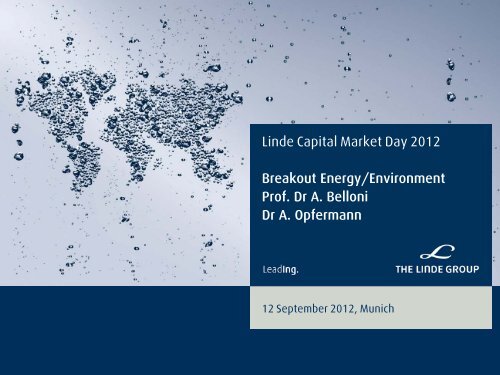

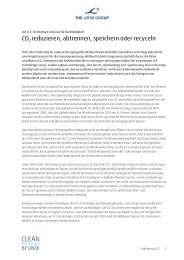

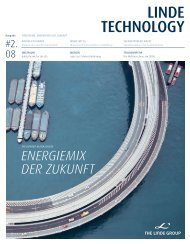

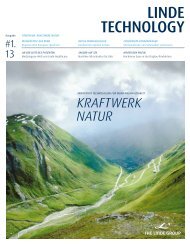
![[41] Anteilsbesitzliste des Linde Konzerns und ... - The Linde Group](https://img.yumpu.com/8356102/1/184x260/41-anteilsbesitzliste-des-linde-konzerns-und-the-linde-group.jpg?quality=85)
![[41] Anteilsbesitzliste des Linde Konzerns und ... - The Linde Group](https://img.yumpu.com/8356076/1/184x260/41-anteilsbesitzliste-des-linde-konzerns-und-the-linde-group.jpg?quality=85)
